![This trio of jack o' lanterns adorn my neighbors' door. The term jack-o'-lantern is in origin a term for the visual phenomenon ignis fatuus (lit., "foolish fire") known as a will-o'-the-wisp in English folklore. Used especially in East Anglia, its earliest known use dates to the 1660s. The term "will-o'-the-wisp" uses "wisp" (a bundle of sticks or paper sometimes used as a torch) and the proper name "Will": thus, "Will-of-the-torch." The term jack-o'-lantern is of the same construction: "Jack of [the] lantern."](http://www.stephenmorrisauthor.com/wp-content/uploads/2014/10/Pumpkin-Trio.jpg)
This trio of jack o’ lanterns adorn my neighbors’ door. The term jack-o’-lantern is in origin a term for the visual phenomenon ignis fatuus (lit., “foolish fire”) known as a will-o’-the-wisp in English folklore. Used especially in East Anglia, its earliest known use dates to the 1660s. The term “will-o’-the-wisp” uses “wisp” (a bundle of sticks or paper sometimes used as a torch) and the proper name “Will”: thus, “Will-of-the-torch.” The term jack-o’-lantern is of the same construction: “Jack of [the] lantern.”
Pumpkin season has arrived! Pumpkin pies are appearing in grocery stores and pumpkin coffee has been at Dunkin’ Donuts for weeks, as have pumpkin doughnuts and muffins — MMM! And pumpkins have been appearing on doorsteps in anticipation of Hallowe’en, carved into both simple and elaborate patterns and lit with flickering candles inserted into the hollowed shell of the pumpkin.
How did “Jack’s” name get associated with the carved pumpkin lanterns? The story of the Jack-O’-lantern comes in many variants and is similar to the story of Will-o’-the-wisp, with variations in the folklore of Norway, Sweden, England, Ireland, Wales, Germany, Italy and Spain. An old Irish folk tale from the mid-19th Century tells of Stingy Jack, a lazy yet shrewd blacksmith who uses a cross to trap Satan. One story says that Jack tricked Satan into climbing an apple tree, and once he was up there Jack quickly placed crosses around the trunk or carved a cross into the bark, so that Satan couldn’t get down. Another of the story says that Jack was getting chased by some villagers from whom he had stolen, when he met Satan, who claimed it was time for him to die. However, the thief stalled his death by tempting Satan with a chance to bedevil the church-going villagers chasing him. Jack told Satan to turn into a coin with which he would pay for the stolen goods (Satan could take on any shape he wanted); later, when the coin (Satan) disappeared, the Christian villagers would fight over who had stolen it. The Devil agreed to this plan. He turned himself into a silver coin and jumped into Jack’s wallet, only to find himself next to a cross Jack had also picked up in the village. Jack had closed the wallet tight, and the cross stripped the Devil of his powers; and so he was trapped.
In both folktales, Jack only lets Satan go when he agrees never to take his soul. After a while the thief died, as all living things do. Of course, his life had been too sinful for Jack to go to heaven; however, Satan had promised not to take his soul, and so he was barred from hell as well. Jack now had nowhere to go. He asked how he would see where to go, as he had no light, and Satan mockingly tossed him an ember from the flames of Hades, that would never burn out. Jack carved out one of his turnips (which were his favorite food), put the ember inside it, and began endlessly wandering the Earth for a resting place. He became known as “Jack of the Lantern”, or Jack-o’-lantern.
Jack-o-lanterns were also a way of protecting your home against the Undead. People used them specifically to ward away vampires. It was said that the Jack-o-lantern’s light was a way of identifying vampires and, once their identity was known, they would give up their hunt for you


